As an Amazon Associate KitchenwareSets.com earns from qualifying purchases.
9 Genius Kitchen Layout Ideas With Island for Any Home
Is your kitchen a chaotic dance of dodging open cabinet doors, prepping meals on a tiny sliver of counter space, and wishing you had a central spot for everything from homework to happy hour? You’re not alone. Many kitchens, no matter their size, lack a functional heart—a place that organizes workflow, provides much-needed storage, and serves as a natural gathering point for family and friends. This feeling of inefficiency can make the most important room in the house feel cramped and stressful.
Drawing on years of kitchen design analysis, we’ve distilled the most common challenges into actionable solutions, ensuring your island is a masterpiece of form and function. This guide will walk you through 9 genius, visually-inspiring kitchen layout ideas with an island, designed to solve these exact problems. Whether you have a sprawling open-concept space or a narrow galley kitchen, there’s a perfect island solution waiting to transform your home.
Dreaming of a Perfect Kitchen Hub but Don’t Know Where to Start?
A well-designed kitchen island can transform your space by adding storage, seating, and a dedicated prep zone. The key is to balance its size, placement, and features with your kitchen’s overall layout to create a seamless and efficient workflow. An island shouldn’t be an obstacle; it should be the central hub that makes every task easier and more enjoyable. It’s the difference between a kitchen that works against you and one that works for you.
The 4 Golden Rules of Kitchen Island Design
The 4 essential rules for kitchen island design are: 1. Define its primary function (prep, dine, store), 2. Size it proportionally, 3. Maintain 42-48 inches of clearance on all sides, and 4. Ensure it doesn’t obstruct the work triangle. Before you fall in love with a specific style, understanding these non-negotiable fundamentals will guarantee your island is a functional success, not a frustrating roadblock.
- 1. Define its Primary Purpose: What do you need most? More counter space for meal prep? A casual dining spot for the kids? A storage powerhouse for small appliances? Deciding on the island’s main job will dictate its design, from the countertop material to the type of cabinets below.
- 2. Respect Proportions (The 10% Rule): To avoid overwhelming your space, a good rule of thumb is that your island should occupy no more than 10% of the kitchen’s total square footage. It needs to feel like a complementary piece, not a giant monolith.
- 3. Ensure Adequate Clearance (The 42-48 Inch Rule): This is the most critical rule. You must have at least 42 inches of clear walkway space on all sides of the island. In a multi-cook kitchen, 48 inches is even better. This allows for safe movement, comfortable workflow, and the ability to fully open appliance doors (like your dishwasher or oven) without obstruction.
- 4. Maintain the Work Triangle: The kitchen work triangle is the classic ergonomic path between the refrigerator, the sink, and the stove. Your island should enhance this flow, not break it. It can be part of the triangle (e.g., by housing the sink or cooktop) but should never be a barrier you have to walk around to get from one key zone to another.
9 Genius Kitchen Layout Ideas With Island for Any Home
The most popular kitchen layouts with an island include: 1. The Classic L-Shaped with a Center Island, 2. The Spacious U-Shaped with an Internal Island, 3. The Streamlined Galley with a Narrow Island, and 4. The Open-Concept One-Wall with a Defining Island. The perfect layout for you depends entirely on your kitchen’s existing footprint, your family’s needs, and your personal style. We’ve curated these 9 distinct solutions from award-winning designs and real-world functional kitchens to provide you with proven and inspiring options.
1. The L-Shaped Layout with a Central Island Anchor
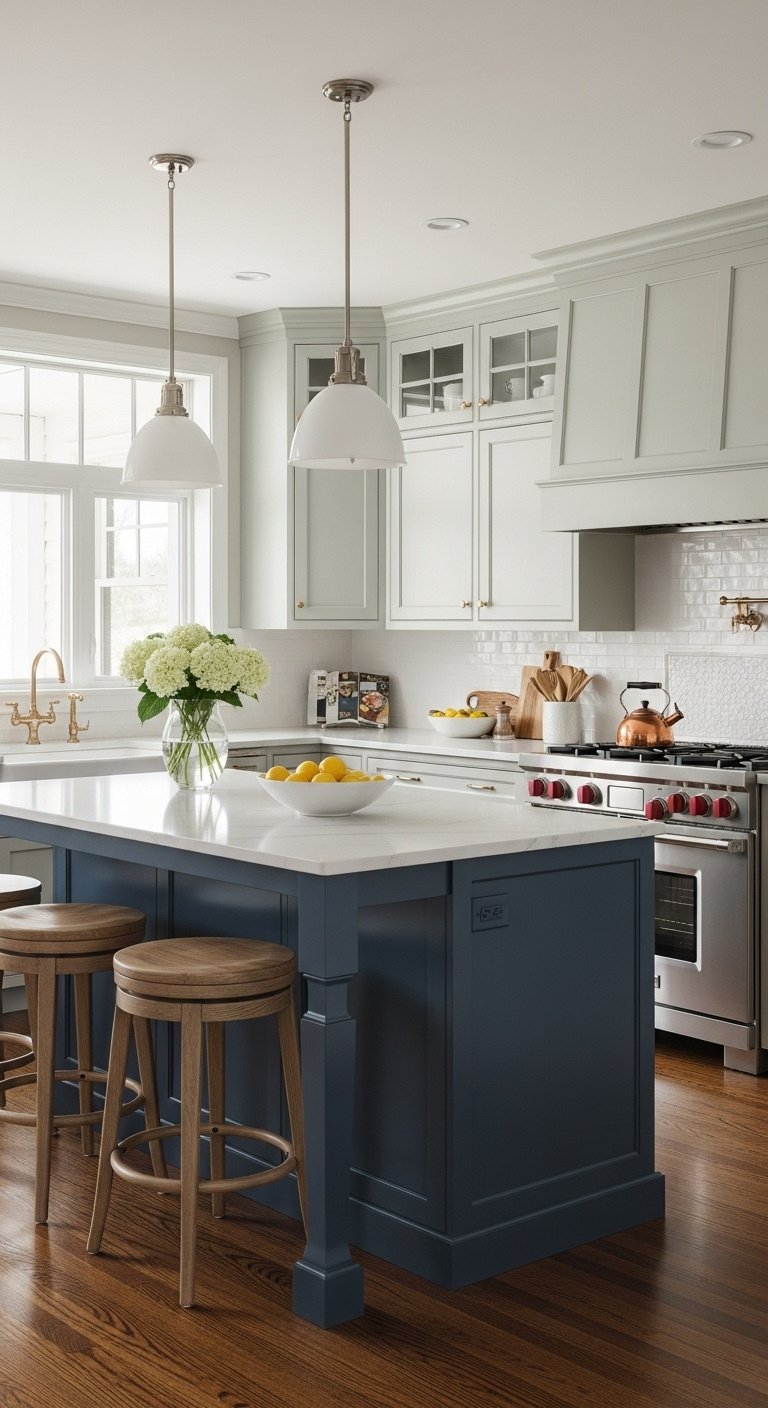
An L-shaped kitchen with an island is one of the most popular and versatile layouts for open-concept homes. This classic combination uses two adjacent walls for cabinets and appliances, leaving ample open floor space for a central island to act as the room’s focal point. It creates a highly efficient work triangle and keeps foot traffic from passing through the main cooking zone.
- Layout Checklist:
- [ ] Measure the longest leg of your “L” to determine maximum island length.
- [ ] Position the island to create parallel workflows with both legs of the “L”.
- [ ] Confirm at least 42 inches of clearance between the island and both cabinet runs.
- [ ] Decide on the island’s function: Is it primarily for prep (facing the stove) or seating (facing away)?
- [ ] Plan for pendant lighting directly above to define the island as a focal point.
Designer’s Pro-Tip: “In an L-shaped kitchen, orienting the island seating to face the living or dining area makes the kitchen feel more social and integrated into an open-concept home.”
Save this classic layout to your ‘Dream Kitchen’ board!
2. The U-Shaped Kitchen with an Efficient Workstation Island
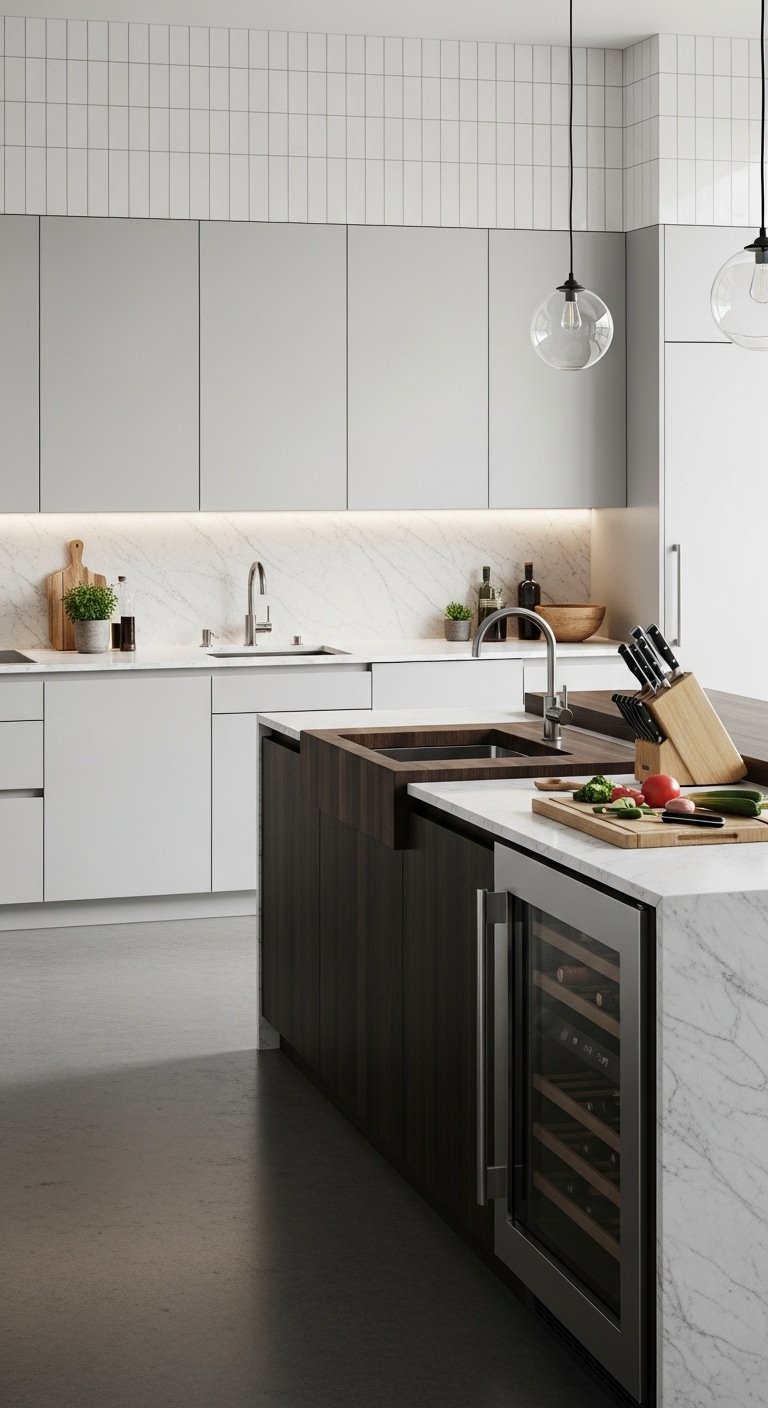
In a large kitchen, a U-shaped layout with an island creates a powerful and contained “cockpit” for the serious cook. This design surrounds you with countertops and appliances on three sides, while the island in the middle becomes a dedicated workstation. This layout excels at separating the cooking zone from the rest of the home, minimizing traffic and maximizing efficiency.
- Layout Checklist:
- [ ] Ensure the “U” is wide enough to accommodate an island plus 42-48 inches of clearance on all three sides.
- [ ] Place the island within the “U” to create a compact work core.
- [ ] Consider adding a prep sink or cooktop to the island to create two distinct work zones.
- [ ] Avoid placing seating on more than one side to prevent traffic jams.
- [ ] If the “U” is smaller, place the island just outside the open end to serve primarily as a seating and serving bar.
Designer’s Pro-Tip: “The island in a U-shaped kitchen is the perfect place for a secondary appliance, like a beverage fridge or microwave drawer, to keep traffic out of the primary cooking zone.”
Pin this efficient U-shaped layout for your renovation plans!
3. The Space-Saving Galley Kitchen with a Slim Island
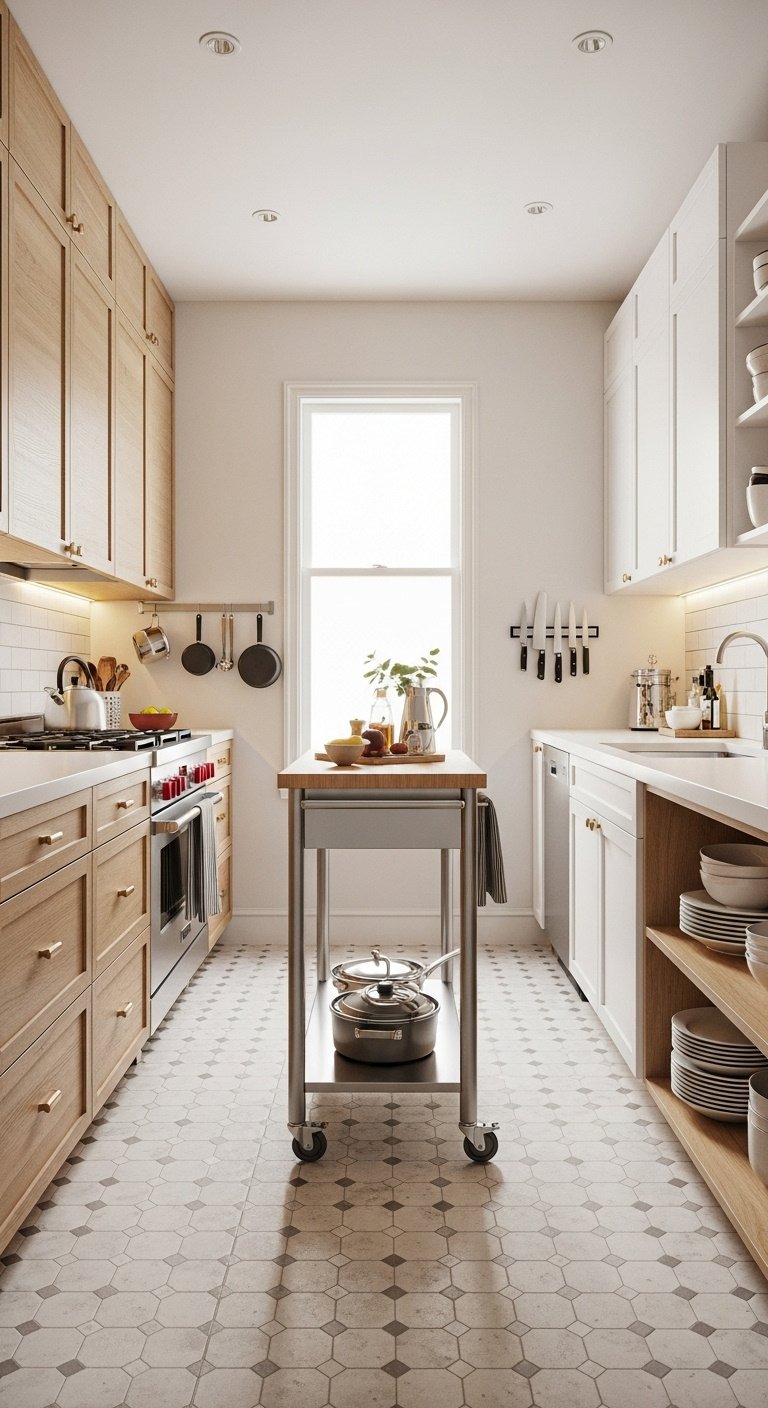
For narrow kitchens, a slim, mobile island is a game-changing solution that adds prep space and storage without a permanent commitment. Traditional galley kitchens, with two parallel walls of cabinets, often feel too tight for a fixed island. A movable cart or a very narrow freestanding island provides the flexibility to have extra counter space when you need it and more floor space when you don’t.
- Layout Checklist:
- [ ] Measure the width between your two parallel countertops. You need a minimum of 8 feet total width to even consider a slim island.
- [ ] Opt for a mobile island or cart (24 inches or less in depth) for maximum flexibility.
- [ ] Choose an island with open shelving below to keep it from looking too bulky.
- [ ] Ensure the island’s material is lightweight for easy movement.
- [ ] Look for models with locking wheels for stability when in use.
Designer’s Pro-Tip: “In a galley kitchen, a mobile island is your best friend. You can use it for prep, then push it to the end of the room to serve as a bar cart or coffee station when entertaining.”
Love this small-space solution? Save it to your ‘Small Kitchen Ideas’ board!
4. The One-Wall Kitchen with a Multipurpose Island
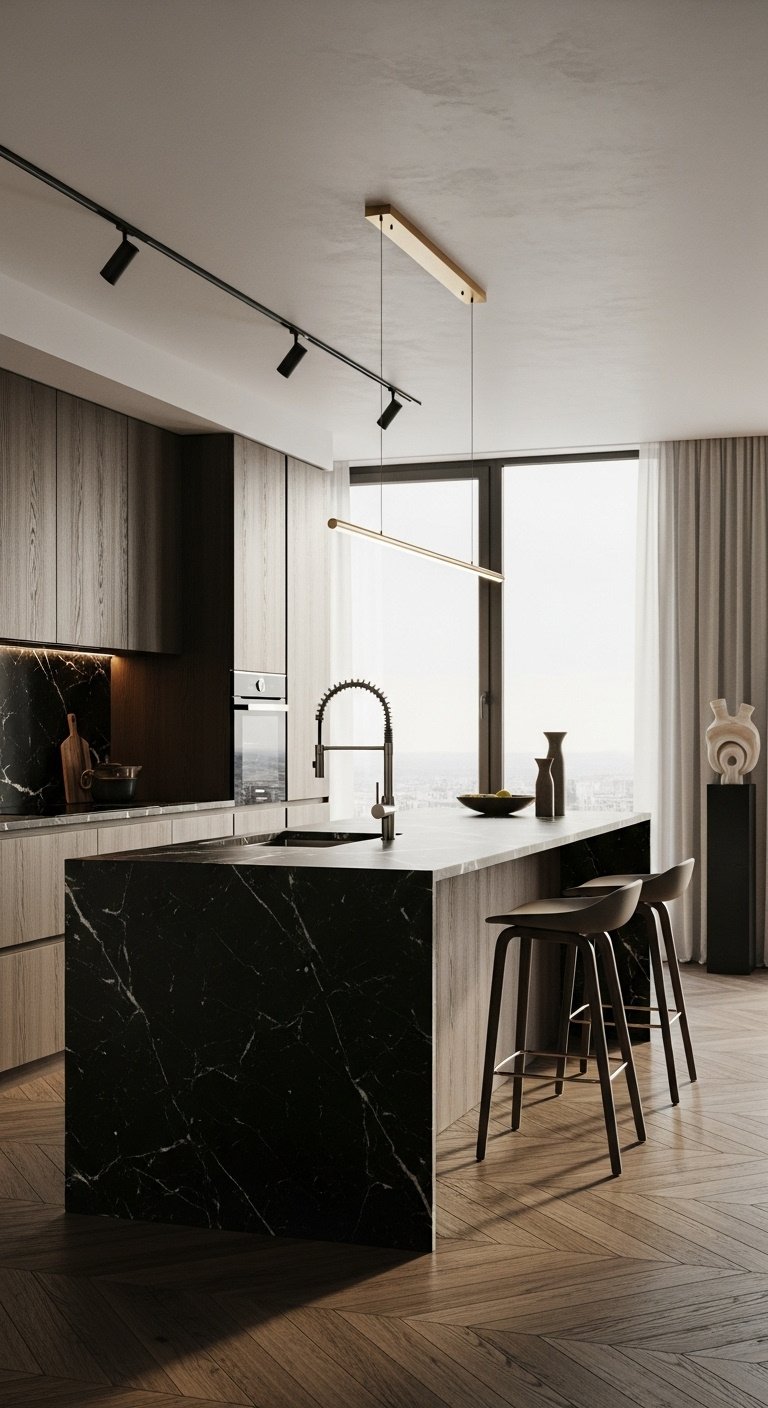
In modern apartments and open-concept spaces, the one-wall kitchen is common. Here, the island is not just an accessory; it is the essential component that makes the kitchen function. It acts as a room divider, a primary work surface, a dining table, and a storage hub all in one. It visually anchors the kitchen zone while housing key appliances like the sink or cooktop to create a functional work triangle.
- Layout Checklist:
- [ ] Use the island to create a visual “wall” that separates the kitchen zone from the living/dining area.
- [ ] Plan for the island to house key functions like the sink or cooktop to create an efficient work triangle with the back wall.
- [ ] Incorporate ample seating to make the island a primary dining spot.
- [ ] A waterfall countertop is a great investment here, as the island is highly visible from all angles.
- [ ] Ensure electrical outlets are planned for the island to power small appliances.
Designer’s Pro-Tip: “For a one-wall kitchen, the island is the kitchen. Don’t be afraid to make it long and dramatic. It should be the hardest working piece of furniture in your home.”
Perfect for open-concept living! Pin this stylish one-wall layout.
5. The Grand Double Island for the Ultimate Entertainer
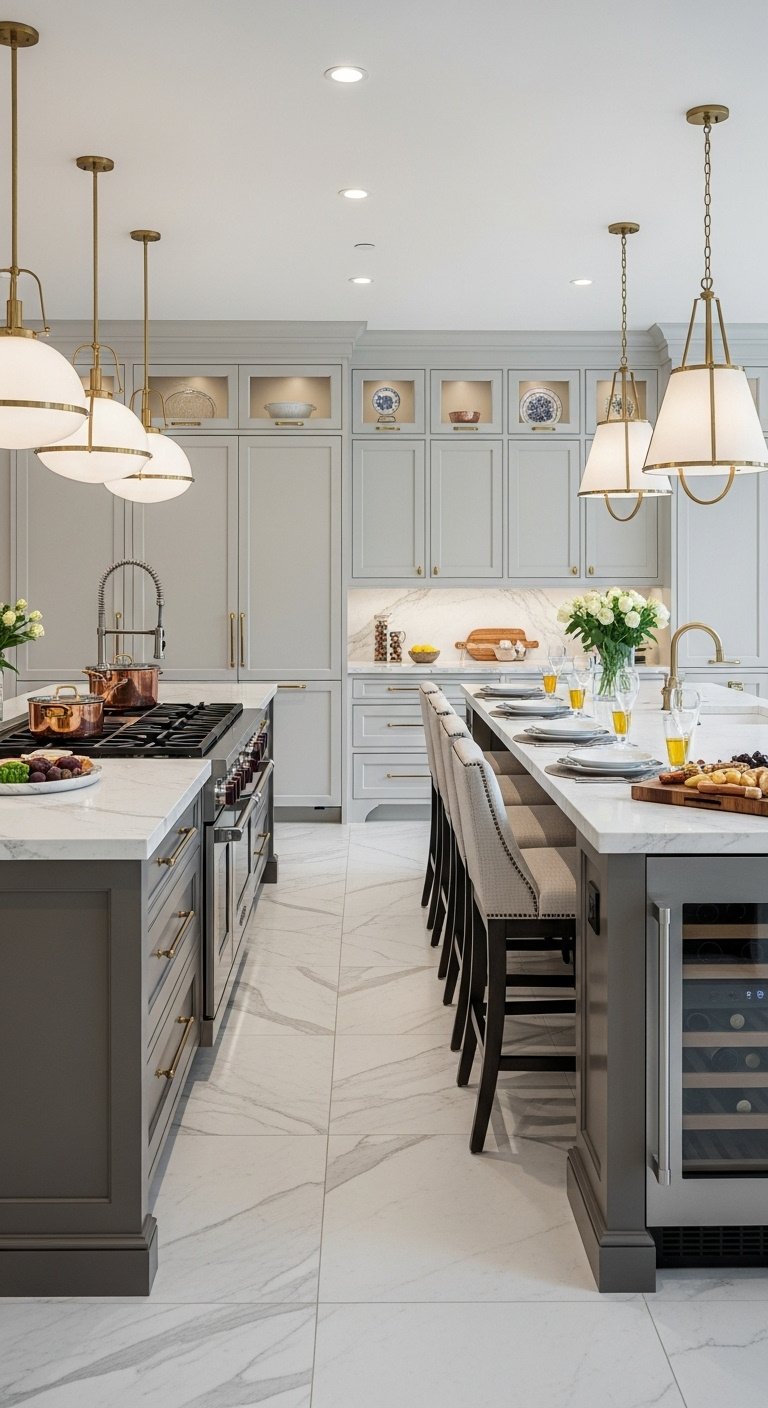
For those with a truly spacious kitchen and a love for hosting, the double island layout is the pinnacle of luxury and functionality. This design dedicates one island purely for work—cooking, prep, and cleaning—and a second parallel island for social activities—seating, serving, and mingling. It effectively creates two zones, allowing the host to cook without interruption while guests relax and socialize nearby.
- Layout Checklist:
- [ ] This layout requires a very large, open-plan kitchen.
- [ ] Designate one island for “work” (cooking, chopping, cleaning) and the other for “social” (seating, serving, homework).
- [ ] Maintain at least 48 inches of clearance in the walkway between the two islands.
- [ ] Ensure the “work” island is part of a tight work triangle with the fridge and wall ovens.
- [ ] Use consistent materials across both islands for a cohesive look, or use contrasting countertops to visually separate their functions.
Designer’s Pro-Tip: “To prevent the space from feeling like a commercial kitchen, use furniture-style details on the ‘social’ island, such as decorative legs or paneling, to soften its look.”
Tag someone who needs this double island kitchen in their life!
6. The Peninsula: The “Connected” Island Solution
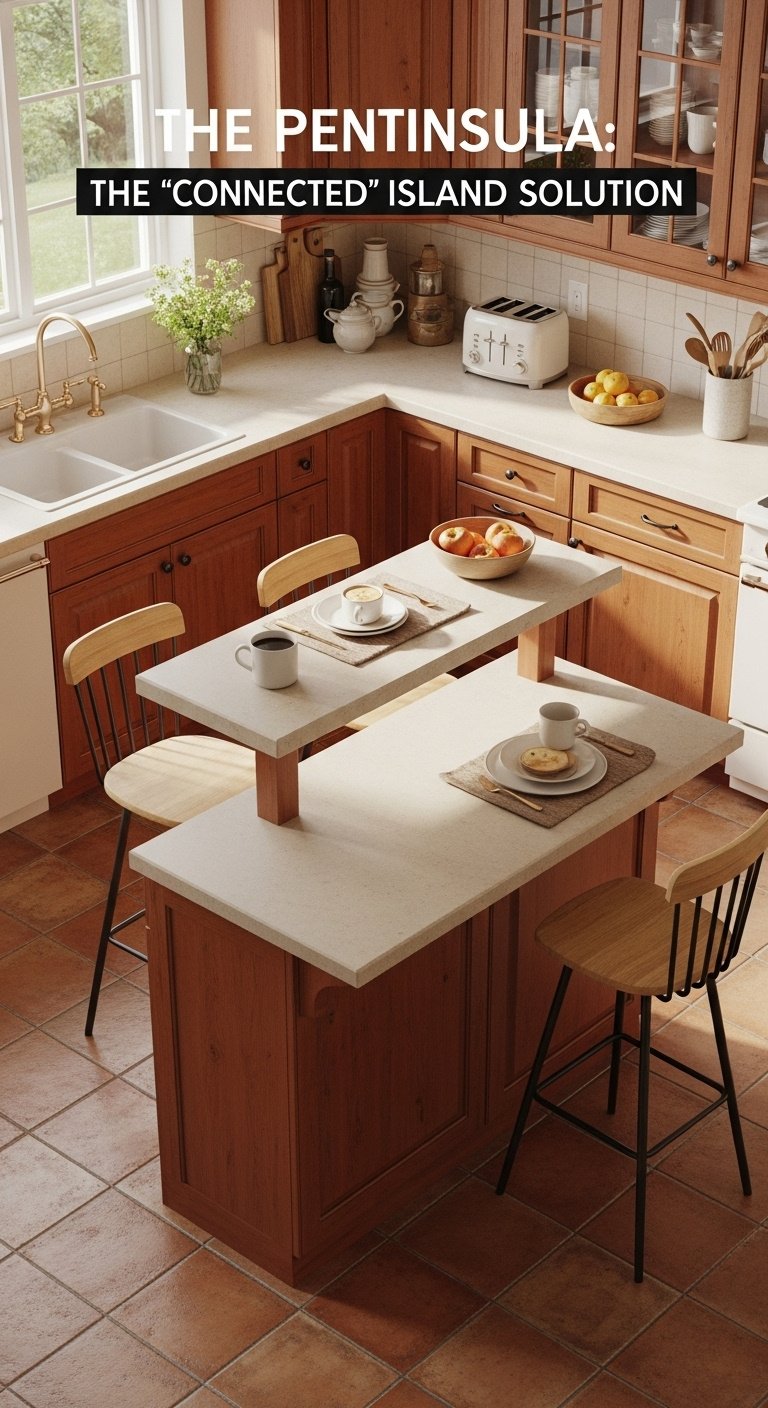
A peninsula is essentially a connected island, offering many of the same benefits without requiring clearance on all four sides. By attaching to a wall or run of cabinets, a peninsula is a brilliant way to add counter space, storage, and seating to a kitchen that is too narrow for a freestanding island. It’s also excellent for defining the kitchen area in a semi-open floor plan.
- Layout Checklist:
- [ ] Ideal for converting an L-shaped or U-shaped kitchen into a more contained G-shaped space.
- [ ] Ensure the entry point into the kitchen remains wide enough (at least 36 inches) for comfortable passage.
- [ ] A peninsula removes the need for clearance on one side, making it great for smaller footprints.
- [ ] Plan for seating on the outside of the peninsula to keep guests out of the main work area.
- [ ] Avoid placing major appliances like the dishwasher at the corner where the peninsula meets the wall, as it can create a bottleneck.
Designer’s Pro-Tip: “A two-tiered peninsula is excellent for hiding kitchen clutter from the adjoining living or dining area. The raised bar top keeps the prep mess out of sight.”
A smart solution for defining space! Save this peninsula idea.
7. The T-Shaped Island: A Hybrid for Dining and Prep
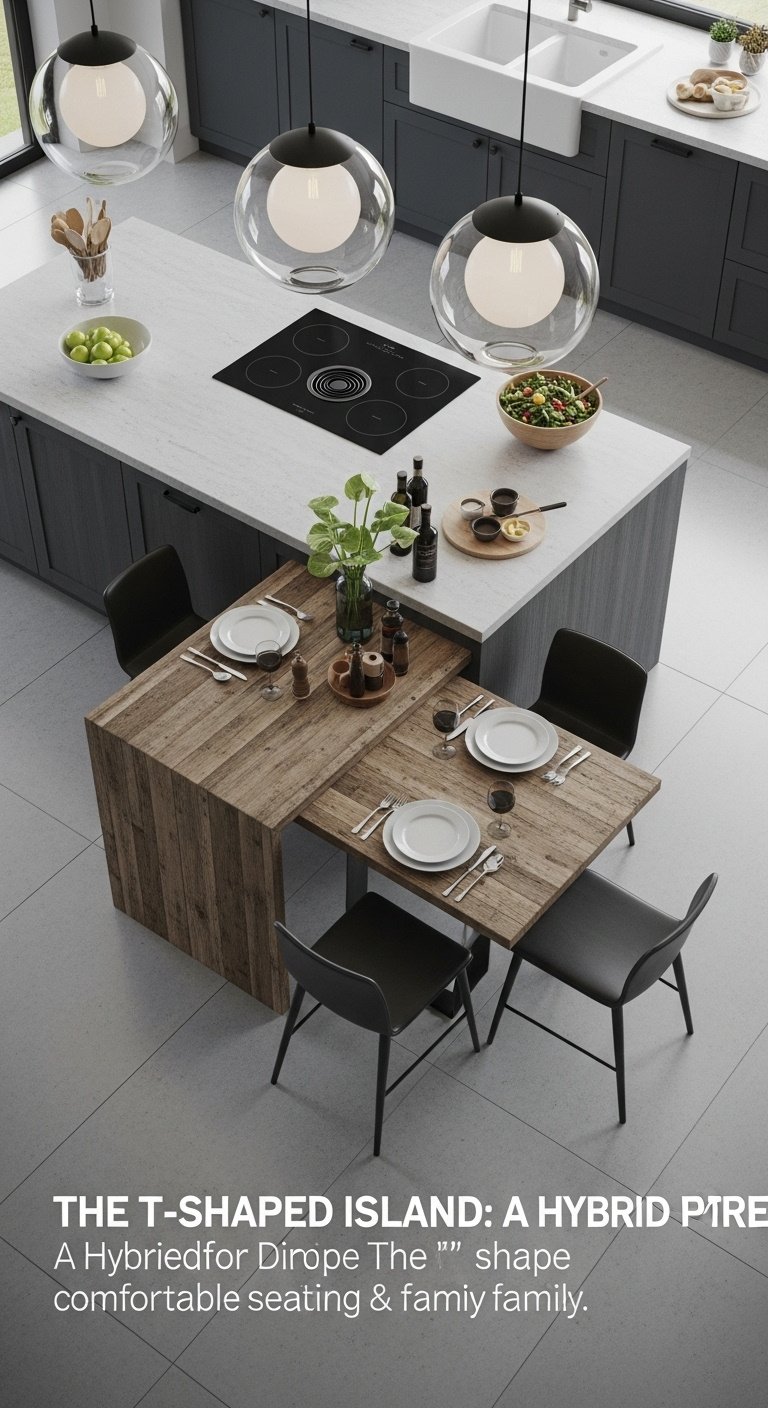
This innovative design combines a standard prep island with an attached dining table to form a T-shape. It’s the perfect solution for homeowners who want more than just bar stool seating. By lowering the dining portion to standard table height (30 inches), it creates a much more comfortable and formal eating experience while still being connected to the heart of the kitchen.
- Layout Checklist:
- [ ] Requires a significant amount of floor space to accommodate the ‘T’ extension.
- [ ] The main island section should align with the kitchen’s work triangle.
- [ ] The dining section should extend into an open area, allowing ample room to pull out chairs.
- [ ] Use a lower, table-height (30 inches) section for the dining part for ergonomic comfort with standard chairs.
- [ ] This is a great opportunity to mix materials, such as a quartz prep surface and a butcher block dining table.
Designer’s Pro-Tip: “Ensure the lighting plan addresses both zones. Use task lighting (pendants) over the prep area and a more ambient chandelier over the dining table portion to define the spaces.”
The best of both worlds! Pin this clever T-shaped island design.
8. The Furniture-Style Island for a Personal Touch

A freestanding, furniture-style island adds immense character and personality, making a kitchen feel unique and collected. Instead of a built-in block of cabinetry, this approach uses a piece that looks more like a vintage workbench, a rustic farm table, or a repurposed dresser. It’s a fantastic way to introduce a different color, texture, or style into the room and is particularly well-suited for smaller kitchens where a bulky built-in would feel overwhelming.
- Layout Checklist:
- [ ] This is an excellent choice for smaller kitchens or those who prefer a less permanent fixture.
- [ ] Choose a piece that is counter-height (36 inches) for comfortable prep work.
- [ ] Look for vintage dressers, workbenches, or console tables that can be repurposed.
- [ ] Ensure the top is sealed properly for food safety (e.g., food-grade wax for butcher block).
- [ ] This option is best for extra prep and storage, not for housing sinks or appliances due to plumbing and electrical needs.
Designer’s Pro-Tip: “Painting a furniture-style island in a bold, contrasting color is an easy way to make it the undeniable star of your kitchen without committing to colored cabinetry everywhere.”
Add character to your kitchen! Save this furniture-style island idea.
9. The Work Table: The Minimalist Island Trend for 2025
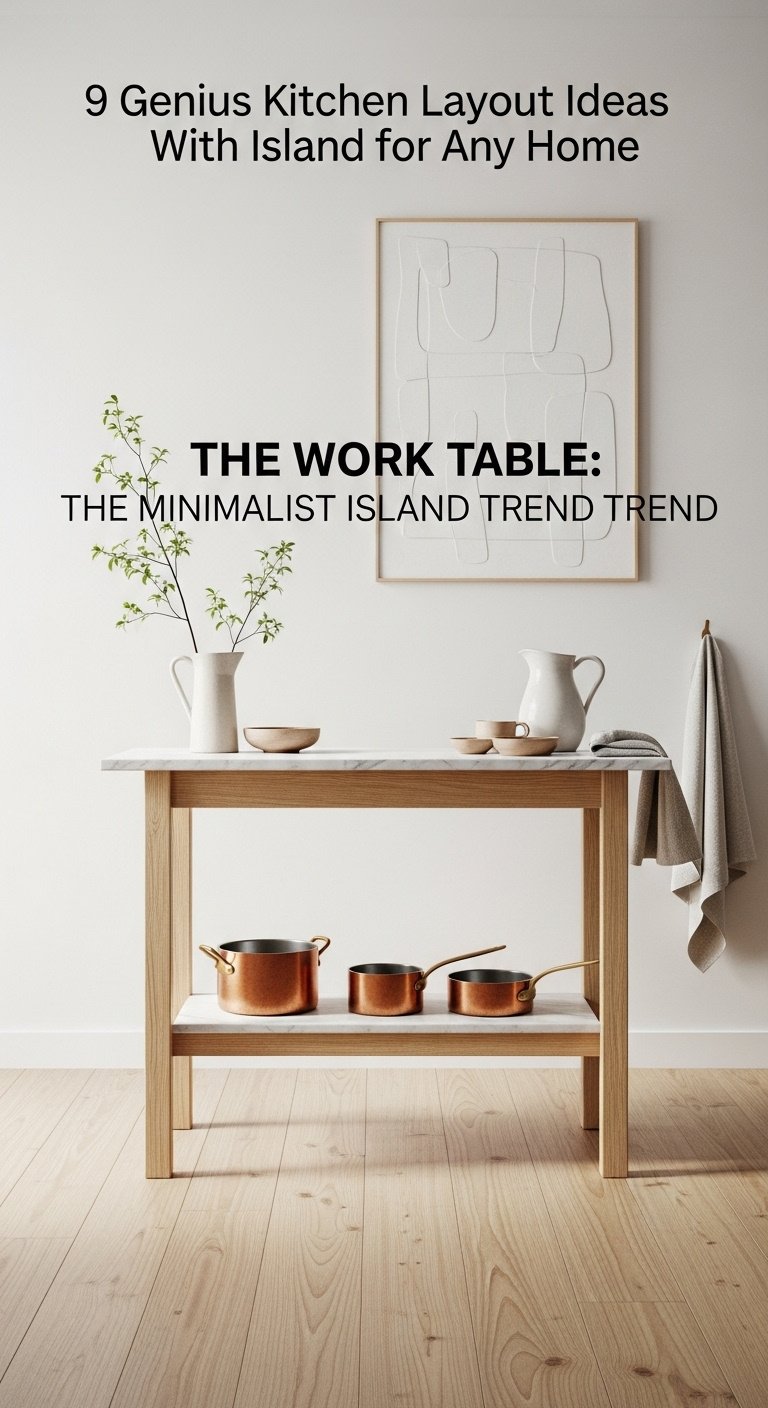
The emerging trend for 2025 is a move away from heavy, built-in islands toward lighter, leggy work tables. This minimalist approach creates a wonderfully airy and uncluttered feel. Because the space underneath is open, it makes the entire kitchen feel larger and less “fitted.” It provides all the necessary prep space without the visual bulk, perfect for kitchens that already have ample cabinetry for storage.
- Layout Checklist:
- [ ] This trend is about creating an airy, less “fitted” look in the kitchen.
- [ ] The open space underneath prevents the kitchen from feeling visually crowded.
- [ ] Ideal for kitchens that already have sufficient cabinet storage.
- [ ] Provides flexible prep space and can double as a casual dining or serving spot.
- [ ] Look for counter-height tables to ensure they are comfortable to work at.
Designer’s Pro-Tip: “The work table trend is a direct response to the desire for more authentic, less ‘designed’ spaces. It feels collected over time rather than installed all at once, adding a layer of soul to the kitchen.”
Get ahead of the trend! Pin this minimalist work table idea.
Key Takeaways: Your Quick Guide to the Perfect Kitchen Island Layout
- Function First: Always decide the island’s primary purpose (prep, seating, storage) before selecting a design.
- Mind the Gap: The golden rule is 42 to 48 inches of clearance around the island for safe and comfortable workflow.
- Proportion is Key: Your island should be no more than 10% of your kitchen’s total square footage to avoid overwhelming the space.
- Respect the Triangle: Ensure your island doesn’t block the natural path between your sink, stove, and refrigerator.
- Match Layout to Footprint: Choose the right island style (L-shaped, Galley, Double) based on your kitchen’s existing shape and size.
People Also Ask About Kitchen Layout Ideas With Island
What is the most efficient kitchen layout with an island?
For most homes, the L-shaped kitchen with a central island is considered highly efficient. It provides an excellent work triangle, keeps traffic out of the core cooking zone, and is open enough for socializing. In larger kitchens, a U-shaped layout with a workstation island can create an incredibly efficient, self-contained prep and cooking area.
What is the new trend replacing the kitchen island for 2025?
The big trend for 2025 is the “work table.” Instead of a bulky, built-in cabinet island, designers are using freestanding, furniture-style tables. This creates a lighter, more airy feel and adds a layer of character, making the kitchen feel less “fitted” and more like a collected, lived-in space.
How do you know if you have room for a kitchen island?
You need at least 42-48 inches of clear floor space around all sides of a potential island. A simple test is to place a cardboard box or tape outline on the floor in your proposed island’s dimensions. Live with it for a few days to see if you can move around comfortably and open all appliance doors fully.
Should a kitchen island be a different color than the cabinets?
A contrasting color for the kitchen island is a very popular and stylish choice. It allows the island to become a true focal point and adds visual interest and depth to the room. Using a different color (like a dark blue island with white cabinets) or a different material (like a wood island with painted cabinets) are both excellent design strategies.
Final Thoughts
Choosing the perfect kitchen island is about so much more than following the latest trends. It’s about honest self-assessment of your space, your habits, and your needs. By understanding the core principles of design and exploring layouts that fit your kitchen’s unique footprint, you can create a functional, beautiful hub that will truly serve as the heart of your home for years to come.
Which of these island layouts would work best in your home? Let us know in the comments below
